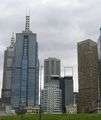Collins Street, Melbourne
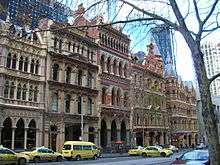 Row of Victorian buildings along Collins Street | |
| Length | 1.6 km (1.0 mi) |
|---|---|
| Location | Melbourne CBD |
| West end | Docklands, Melbourne |
| Major junctions | Spencer Street, King Street / Kings Way, William Street, Queen Street, Elizabeth Street, Swanston Street, Russell Street, Exhibition Street |
| East end | Spring Street, East Melbourne |
Collins Street is a major street in the centre of Melbourne, Victoria, Australia. Often regarded as Australia's premier street, it is Melbourne's traditional main street, known for its grand Victorian architecture, prestigious boutiques and high-end retailers. The length of the thoroughfare between Elizabeth Street and King Street has long been the financial heart of Melbourne and is home to various banks and insurance companies.
The eastern end of the street was known as the 'Paris End' due to its shopping and alfresco dining culture, now mythologised as part of the "Marvellous Melbourne" boom period.[1]
History
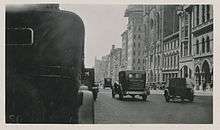
As laid out by the surveyor Robert Hoddle, it was exactly one mile in length and one and half chains (99 feet (30 m)) wide. Collins Street was named after Lieutenant-Governor David Collins who led a group of settlers in establishing a short-lived settlement at Sorrento on the Mornington Peninsula south of Melbourne in the early 19th century. He subsequently became the first governor of the colony of Van Diemen's Land, later to become Tasmania.[1]
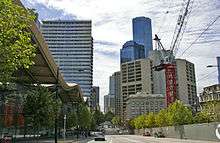
At the western end of the street was Batman's Hill, named for the Tasmanian adventurer and grazier John Batman, who built a house at the base in April 1836, where he lived until his death in 1839.[2]
The first major street improvements were carried out in the mid-1850s, including bluestone curbs and gutters, and the introduction of gas lighting in 1855. The first street trees were elms, planted in 1875. A cable tram line was laid in 1886 and was operational until 1930.[1]
Throughout the late 19th and early 20th centuries, the top end of Collins Street was dominated by the rooms of medical professionals. The prestigious Melbourne Club was a dominant cultural presence. It was also the location of Grosvenor Chambers (9 Collins Street) which was Australia's first custom designed studio complex, and was used by many prominent Australian artists.[3]
Around the turn of the 20th century "doing the Block" became a pastime for shoppers at the Block Arcade area in the retail heart of the street between Elizabeth and Swanston Streets.
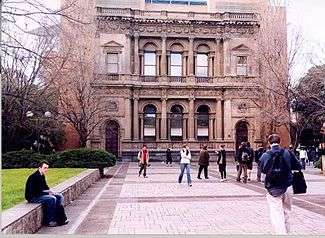
The Bank of New South Wales Melbourne office earned architect Joseph Reed a first prize in architecture. When the building was demolished in 1935, the facade was transferred to the University of Melbourne to become the Commerce building and is now retained on the facade of the new building being constructed for the Faculty of Architecture, Building and Planning.
During the 1950s and 1960s, the street became subject to extensive redevelopment and many historic buildings were demolished by Whelan the Wrecker, despite the efforts of the National Trust and the "Save Collins Street" group. While some examples of boom style architecture survive, the grandest examples were lost to the wrecker's ball.[4] Of the major losses, the most significant were the large Victorian buildings including the Federal Coffee Palace, Colonial Mutual Life building, Robb's buildings, Queen Victoria Buildings, City of Melbourne Bank, Scott's Hotel, Melbourne Mansions and APA building. Many of the buildings destroyed in this era were documented by architectural photographer Mark Strizic and can be found in the archives of the State Library of Victoria.
Between 2003–05, Collins Street was extended west beyond Spencer Street, starting with the opening of the bridge over Southern Cross station and Wurundjeri Way on 18 December 2002,[5] with the street currently ending outside the new ANZ and Myer headquarters further in the Docklands development. It will eventually extend further west in the future, as part of the new redevelopment. This will create an intersection between Bourke Street and Collins Streets, two of Melbourne's most important streets.
Architecture

As Melbourne's commercial and former shopping centre, Collins Street possesses some of Melbourne's best examples of Victorian architecture. Large churches include the Collins Street Baptist Church (1845), the St Michael's Uniting Church (1866) and the Scot's Presbyterian Church (1874).

Significant commercial buildings include Alston's Corner (1914) by Nahum Barnet is an excellent surviving example of Edwardian architecture, while the Block Arcade by D.C Askew (1893) is an excellent example of high Victorian mannerist architecture. Towards the financial end are some great examples of high Victorian gothic architecture or "Cathedrals of Commerce". They include William Pitt's Venetian Gothic style Old Stock Exchange (1888), William Wardell's Gothic Bank (1883) which features some of Melbourne's finest interiors and A.C Goode House designed by Wright, Reed & Beaver (1891).
The old Commonwealth Bank of Australia Banking domed Chamber exists within the post modern 333 Collins Street tower. It was designed by Lloyd Tayler and Alfred Dunn and built in 1891. Some of Australia's tallest buildings are along Collins Street, including the Rialto Towers, Collins Place towers 1 & 2, Nauru House, 120 Collins Street and 101 Collins Street and ANZ World Headquarters (at 380 Collins Street, which is integrated into the old Stock Exchange and Gothic Bank).
Theatres
Collins Street is home to the Athenaeum and Regent theatres, both of which host Australian and international theatre productions and live performances throughout the year.
Shopping and boutiques

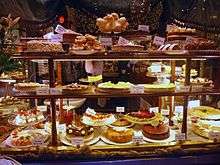
Collins Street is Melbourne's premier shopping street and retailers with flagship stores there include: Prada,[6] Louis Vuitton,[7] Emporio Armani,[8] Tiffany & Co,[9] BVLGARI,[10] Giorgio Armani, Dior, Ralph Lauren,[11] TAG Heuer,[12] Paspaley, Cartier,[13] Gucci, Ermenegildo Zegna, Bally, Coach, Max Mara, Hermès, Dolce & Gabbana, Christian Louboutin, Tom Ford, Hugo Boss, Rolex, Georg Jensen, Paul Smith, Thomas Pink, Stuart Weitzman, Longchamp, Lloyd, Wolford, Montblanc, Franck Muller, Harrolds.[14]
Major shopping centres include Collins Place, Block Arcade, Georges on Collins, St. Collins Lane, Collins 234, and Centreway.
Hotels
There are many hotels located on Collins Street. Major hotels include: Sofitel Melbourne on Collins, The Grand Hyatt Melbourne, The Westin Melbourne, Novotel Melbourne on Collins, InterContinental Melbourne at the Rialto.
Public art
One of the most popular statues in Melbourne, Larry La Trobe created by artist Pamela Irving, faces Collins Street from the northern end of Melbourne City Square.
Institutions
The Melbourne Club is on Collins Street. The renaissance revival style buildings were designed by Leonard Terry and built in 1845.
The Reserve Bank of Australia's Victorian branch is located on Collins Street. Its 1960 buildings were once the national office for the bank.
Most of the global investment banks such as Goldman Sachs and Lazard have their Melbourne headquarters located on Collins Street, with the majority in the prestigious 101 Collins Street. This contributes to the reputation that Collins Street enjoys to this day.
Transport
Trams (routes 11, 12, 48 and 109) run down Collins Street, mainly to Melbourne's eastern suburbs and the Docklands precinct.
Gallery
-

Collins Street. East from Swanston Street
-

Collins Street. West from Swanston Street
-
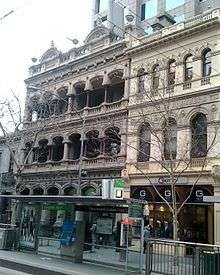
Grosvenor Chambers. 9 Collins Street
-
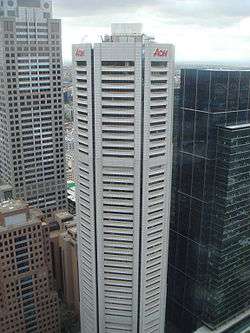
Nauru House, 80 Collins Street
-
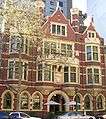
Professional Chambers building. 110-114 Collins Street
-
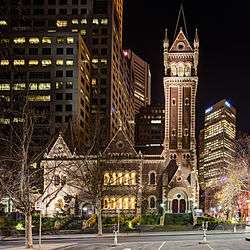
St Michael's Uniting Church (at night), 122 Collins Street
-
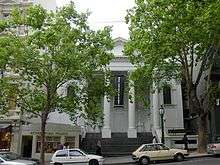
Baptist Church, 174 Collins Street
-

Regent Theatre. 191 Collins Street
-
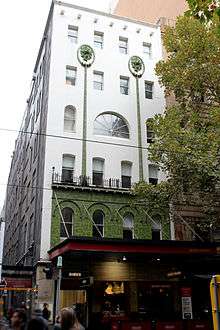
Former Fourth Victoria Building, 243 Collins Street
-

The Block Arcade. 282 Collins Street
-
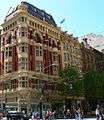
Alston's Corner. 298 Collins Street
-

Hardy Brothers Building. 338 Collins Street
-

Former Stock Exchange. 376 Collins Street
-
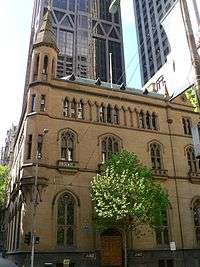
ANZ Bank. 390 Collins Street
-
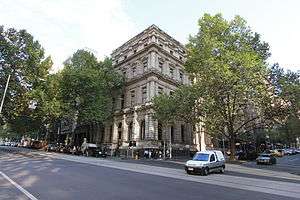
Former Bank of Australasia. 394 Collins Street
-

Temple Court Building. 422-428 Collins Street
-

470-495 Collins St
-

Olderfleet buildings. 471-477 Collins Street
-

Formerly Meridien Hotel, later Intercontinental Hotel. 495 Collins Street
-
Rialto Towers. 525 Collins Street
-

530 Collins Street
-
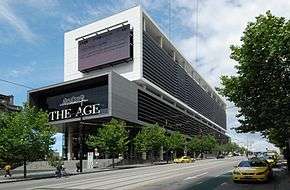
The Age Building. 655 Collins Street
-

Collins Street, evening. 1931 painting by Clarice Beckett
Collins St., 5 pm. 1955 painting by Australian artist John Brack
See also
![]() Australian Roads portal
Australian Roads portal
References
- 1 2 3 Judith Buckrich: Collins – The Story of Australia's Premier Street, 2005, ISBN 1-74097-057-8
- ↑ "Batman, John (1801–1839)". Australian Dictionary of Biography, Online Edition. adb.online.anu.edu.au. Retrieved 6 July 2008.
- ↑ see Alex Taylor, Perils of the Studio: Inside the Artistic Affairs of Bohemian Melbourne,Australian Scholarly Publishing & State Library of Victoria: North Melbourne, 2007
- ↑ Annear, Robyn (2005). A city lost & found : Whelan the Wrecker's Melbourne. Black Inc, Melbourne. ISBN 1863953892.
- ↑ "Operations". Newsrail. Australian Railway Historical Society. January 2003. p. 25.
- ↑ "PRADA Australia flagship store Collins Street > Shopping". Fashionising.com. 15 April 2008. Retrieved 29 January 2012.
- ↑ "Collins Street Precinct – Home". Collinsstreet.com.au. Retrieved 29 January 2012.
- ↑ "Collins Street and Little Collins Street, Melbourne". Visit Melbourne. Tourism Victoria. Retrieved 25 July 2011.
- ↑ "Tiffany & Co. | Tiffany Jewelry Store | Melbourne Collins Street | Australia". Au.tiffany.com. Retrieved 29 January 2012.
- ↑ "Bvlgari opens flagship in Melbourne". Jewellery World. 30 September 2011. Retrieved 29 January 2012.
- ↑ "store+makeover,1238". Vogue.com.au. Retrieved 29 January 2012.
- ↑ "TAG Heuer Melbourne – 330 Collins Street Melbourne, Victoria – TAG Heuer Australia". Tagheuer.com.au. Retrieved 29 January 2012.
- ↑ "Cartier Australia flagship store Collins Street > Shopping". Fashionising.com. 15 April 2008. Retrieved 15 February 2012.
- ↑ Safe, Georgina (16 June 2010). "Tom Ford's single outlet". The Australian.
Coordinates: 37°49′00″S 144°57′44″E / 37.8168°S 144.9622°E
